Squarespace Vs Shopify Vs Wix
We follow a strict honesty policy. However, to fund our work, we use affiliate advertising links on this blog.

In this Wix vs Shopify comparison, we take an in-depth look at both platforms and help you decide which is the best option for building your website or online store.
Read on to get a full list of pros and cons of these platforms, along with our take on the best alternatives — and do feel free to leave your thoughts on both products in the comments section!
Let's dive in — with key question…
What are Wix and Shopify?
On the surface, Wix and Shopify look like similar tools, promising to give you everything you need to build a website or online store — and without needing to code.
But both of these platforms started life with very different purposes in mind.
Wix was initially conceived as a solution for building content-based websites, for users wishing to create
-
brochure sites
-
blogs
-
photography portfolios
-
news sites
and other websites where conveying information or showcasing content was the key priority.

By contrast, Shopify was specifically designed to be a solution for creating an online store, so all its features have always been 100% geared towards selling products.
But over the years, both products' feature sets have changed considerably — Wix now boasts a lot more selling features than it used to, and Shopify's content management tools have evolved considerably too. This means that you can now use either tool to create a content-heavy website or an online store.

However, because of their history, you will probably find that Wix usually remains the better option for building content-driven websites, and Shopify the better bet for ecommerce.
It's not always that simple however, so before making a decision, it's worth drilling down into Wix and Shopify's pricing, key features and user-friendliness in some depth.
Let's start with pricing.
Wix and Shopify pricing
Free plans and trials
The most significant difference between Wix and Shopify's approach to pricing is that Wix offers an entirely free plan.
Shopify, by contrast, offers a two-week free trial (this can usually be extended upon request, however).
Wix's free plan is limited in functionality — you can't sell anything with it, or connect a domain to it — and it's got hard-to-avoid Wix advertising on it. But even so, it's a good way to try the platform out.

Wix pricing
When it comes to Wix's paid-for plans, in the USA there are eight paid-for plans available, divided into three categories: 'Website,' 'Business and Ecommerce' and 'Enterprise.'
(If you're based outside the US, the pricing structure is usually fairly similar — but the names of plans may be slightly different).
The 'Website' plans range from $14 to $39 per month and, as the category name suggests, are focused on allowing you to build a 'general' website (the kind of brochure or portfolio sites discussed above).
The 'Business and Ecommerce' plans range from $23 to $49 per month, and add ecommerce functionality to the mix, meaning that you can sell products on your Wix site.
The full range of the Wix plans is as follows:
Website plans
-
Combo — $14 per month
-
Unlimited — $18 per month
-
Pro — $23 per month
-
VIP — $39 per month
Business and Ecommerce plans
-
Business Basic — $23 per month
-
Business Unlimited — $27 per month
-
Business VIP — $49 per month
Enterprise plans
- Wix Enterprise (from $500 per month)
The main differences to watch out for with regard to the Wix premium plans are:
-
Storage space (text, video, images etc.) — this varies according to plan, with the more expensive plans offering more of it.
-
Access to certain apps — these include a 'site booster' app which allows you to submit your site to directories; an analytics app; an events calendar app; and a logo-making app.
-
Video minutes — the more you pay, the more video content you can upload to (and sell from) your Wix website.
-
Ecommerce features — these are only available on the 'business and ecommerce' plans, and more selling functionality is unlocked the higher the plan.
-
Support — premium support is only available on the VIP or Enterprise plans.
For me, the best-value Wix plans are the 'Pro' and 'Business Basic' plans, as their feature to price ratio is good, and both plans cover the basics for those needing a brochure website or online store respectively.
A quick note about the 'Wix Enterprise' plan: as the name and price tag of $500+ per month suggest, this is geared towards more corporate users. Fundamentally, the main difference between this and the other plans is a lot more hand-holding and access to consultants.
Most users won't really need to consider a Wix Enterprise subscription, but if you are interested in it, you'll need to request a call with Wix to negotiate pricing for your requirements.
Shopify pricing
Shopify's pricing structure is a bit simpler than Wix's.
There are five Shopify pricing plans to choose from, with names and features broadly consistent across countries:
-
Shopify Lite — $9 per month
-
Basic Shopify — $29 per month
-
Shopify — $79 per month
-
Advanced Shopify — $299 per month
-
Shopify Plus — fees are negotiable, but in the region of $2,000 per month.
As discussed above, unlike Wix there is no free plan available for Shopify, but a two-week free trial is available, which you can access here.

At the cheapest end of the scale, we have the 'Lite' plan. This does not actually allow you to construct a fully-functional, standalone online store; rather, it:
-
lets you sell via your Facebook page
-
allows you to use Shopify in a physical location to sell goods or manage inventory
-
gives you access to Shopify's Buy Button, which allows you to sell goods on an existing website, social media profile or blog.
The key differences between the other Shopify plans involve:
-
the number of users who can access an account — the higher the plan, the more users you can have
-
professional reporting (only available on 'Shopify' or higher plans)
-
shipping discounts — in some territories, you can avail of big shipping discounts if you use certain local couriers (the size of the discount depends on the plan
) -
third-party shipping rate calculations (available on the 'Advanced Shopify' plan)
- multi-currency features — on the 'Shopify' plans or higher, you can set your own currency conversion rates
Like 'Wix Enterprise,' Shopify Plus is pitched as an enterprise-grade solution, which basically offers advanced features involving security, APIs, task automation and fulfilment.
Shopify Plus is expensive — you can expect to pay around $2000 per month for it, but it is a truly enterprise-grade solution that has been used by big corporates like Sony, Pepsico and Unilever. (You can learn more about the differences between Shopify and Shopify Plus here).
Whether you can really say the same about the 'Wix Enterprise' plan is debatable.
Transaction fees and credit card rates
In addition to monthly fees, there are also credit card rates to consider.
Shopify and Wix charge similar credit card processing fees when you use their built-in payment processors — Shopify Payments and Wix Payments respectively: 2.4% to 2.9%.
(These are the rates for the US and it can be cheaper in other territories — for example, the EU transaction fee for Wix Payments is 1.9%; the UK rate for Shopify Payments can go as low as 1.5% if you're on a high-tier plan).
It's important to note that Shopify takes a percentage of your sales if you use a third-party payment gateway. These fees vary from 0.5% to 2.0%, depending on the plan you're on.
The problem here is that Shopify Payments is not available in all countries — so depending on your territory, you may have to use a third-party payment gateway — and end up facing two sets of transaction fees.
Wix doesn't charge you for using a third-party payment gateway, so it's a bit of a win for Wix here.
Some quick conclusions on Wix vs Shopify pricing
For me the bottom line on Wix vs Shopify pricing is this: if you're hoping to build a 'general' website showcasing content rather than products, then Wix is considerably better value.
Using Wix, you can get a decent content site off the ground for $14 per month.
You'd have to spend over twice that to do something similar with Shopify — but then again, if you are hoping to build a content-only site, Shopify is not really the obvious solution for you!
If you are looking at building an ecommerce site, this is also technically cheaper with Wix — its $23 entry-level ecommerce plan works out at $6 per month cheaper than the Shopify equivalent.
And the fact that no transaction fees apply if you use a third-party payment gateway compares positively with Shopify.
But in order to make a call on which of these two products offers more value, you'll need to drill down into the quality of ecommerce features available in each — and as we'll see later, it's in this area that Shopify brings some really strong functionality to the table.
I'll walk you through all of Wix's and Shopify's key ecommerce features in just a moment — but before I do that, let's look at something that a lot of people understandably prioritise when choosing a website builder: visuals.
Templates
At the heart of Wix and Shopify's approach to web design is a set of pre-designed templates (in Shopify, these are referred to as 'themes'). You pick one of these, add some text and images to it, and it forms the basis of your site or store's design.
Your template should be thought of as something of a starting point, though — the colors and typefaces included with it can all be customized or changed to match those of your brand.
Quantity of templates
When you create a Wix account, you get to choose from over 800 included templates. This is considerably more than the 10 free themes bundled with Shopify.
That said, the Shopify templates all come in 2-3 variants, meaning there is a bit more template choice available from Shopify than these numbers initially suggest.
And, if you're not entirely happy with the free templates provided with Shopify, there is always the option to purchase a premium theme (there are 70 of these available, each containing a few variants, which vary in price from $150 to $350).
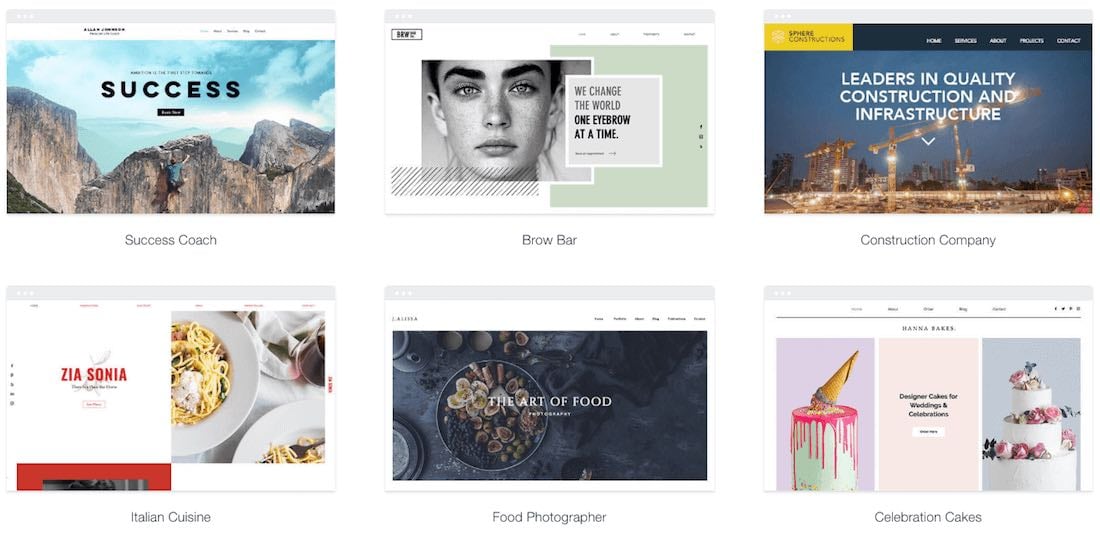
Ultimately, in terms of quantity of templates, Wix is the winner.
But what about quality?
Quality of templates
In terms of quality, both platforms' templates are professional in appearance and contemporary in terms of their design.
As you might expect, the Shopify themes are geared exclusively towards ecommerce, and are arguably more robust for use in that context.

Wix offers a much greater range of general-purpose templates though — so if your aim is to build a content-driven site, there's far more on offer from Wix.
I prefer the way that you can choose templates in Shopify, however. You can filter templates by a significantly wider range of criteria, relating to content, features and aesthetics.
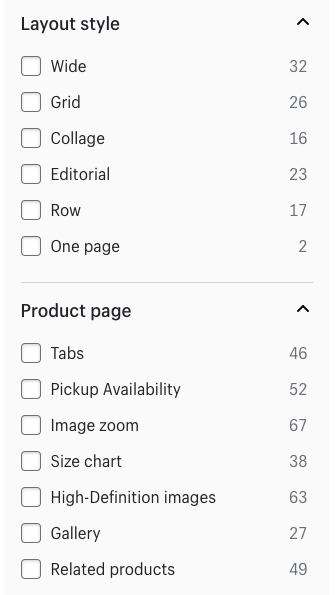
For example, you can look for templates which are best suited to small or large product catalogues; filter by visual effects (parallax effects, video backgrounds etc.); or filter by layout type (wide, narrow, etc.
Wix, by contrast, only categorises its templates by industry or business type.
The bottom line on template quality is that if you're looking for a dedicated ecommerce template, Shopify arguably provides you with stronger templates and a better way to choose one. You can browse all the Shopify templates here.
Wix is the more obvious choice, however, for general-purpose templates.
Template performance on mobile devices
Shopify's templates are all 100% responsive, meaning that their components — text, images, forms etc. — will automatically resize themselves to suit the device that they're being viewed on (for example a desktop computer, mobile, or tablet).
Wix by contrast uses something called absolute positioning, where web elements are positioned by pixel.
In practice this means that you have to create two versions of your Wix website — one for desktop, and one for mobile. This means more work for you as an end user.
Now, to be fair to Wix, the platform does a pretty good job of doing of sorting the mobile version out automatically for you — you won't always have to change it, especially if you are making minimal edits to a template.
However, there will inevitably be times where you have to tweak it a bit to ensure that the mobile version of your Wix site displays nicely.
This is not always a bad thing. A benefit of being able to edit both the desktop and mobile versions of your site is that you can create a more streamlined version of the latter, by hiding elements that might feel a bit superfluous for mobile users. This isn't really possible on a Shopify site without resorting to coding.
But overall, I much prefer responsive templates to those that make use of absolute positioning. Absolute positioning goes against best web design practice; and significantly, it goes against Google's advice on creating a search-friendly mobile site too.
Given that Google now uses mobile search results to inform all search results, this situation isn't ideal.
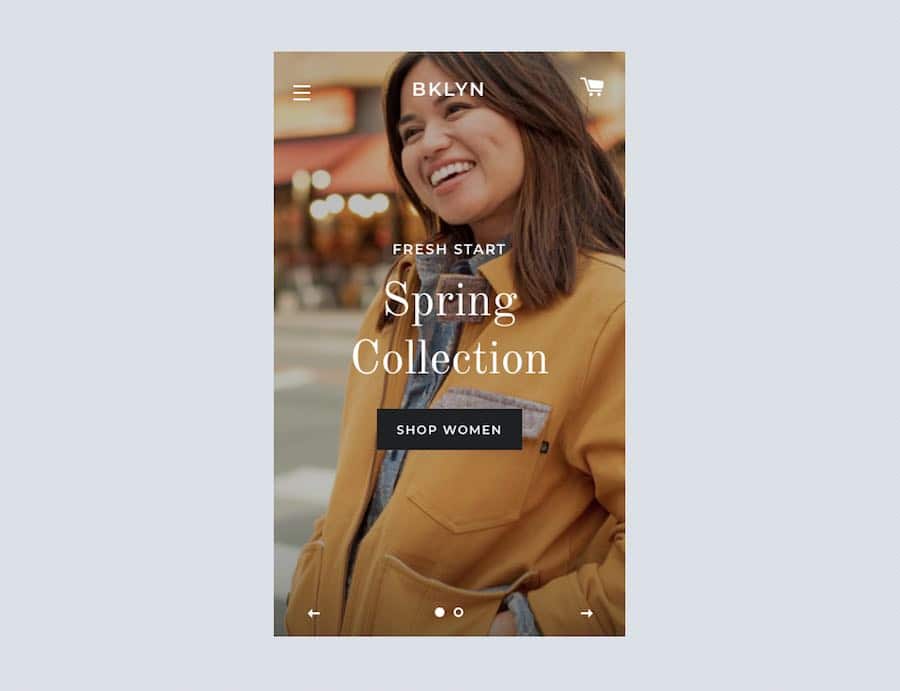
To be fair to Wix however, the company is making ongoing efforts to improve the performance of its sites on mobile devices, and Google is on record as saying Wix sites work fine from an SEO perspective.
Additionally, a new version of Wix — Editor X — has recently been released which does facilitate responsive design. This is currently aimed at developers and agencies rather than general users, but it's an interesting development nonetheless.
Ultimately, Wix's approach to displaying content on mobile devices shouldn't be seen a total showstopper. But if you're working in an ultra-competitive niche, you may find that there is a bit more SEO value in Shopify's approach to template design.
Styling and switching templates
When it comes to styling or switching templates, Shopify is a hands-down winner over Wix.
First, you get full access to the CSS and HTML code of your template in Shopify. This is not the case in Wix unless you are using the developer version of the product ('Velo' — which won't be for everyone).
Additionally, Shopify makes it very easy to switch templates. With Wix, if you want to switch to another template, you will have to rebuild your whole site.
So if it's design flexibility you're after, the better choice is definitely Shopify.

Content management and interface
Ease-of-use
Wix provides 3 interfaces for building websites:
-
Wix Editor
-
Wix ADI
-
Velo by Wix (formerly 'Corvid')
The 'Wix Editor' option allows you to pick a template, create a structure for your site, and then populate it with content. This is probably the best option for most users.
'Wix ADI' mode ('Artificial Design Intelligence') automatically creates a customizable website for you complete with images, video, and text.
This is done by asking you a few questions about what you're trying to achieve, and then populating your site with publicly-available information about you or your business from the web.
How good the content Wix ADI pulls is a bit of a hit-and-miss affair really, and will depend on the quantity, quality and relevance of information Wix finds about you online.
Wix ADI is very easy to use, however — so even if it doesn't quite pull the appropriate content for your site, the content it does present will be easy for you to edit.
Finally, there's 'Velo,' which provides access to the platform's APIs (i.e., some aspects of Wix's code). Velo permits the addition of greater functionality to Wix sites, and more control over their design, but you will need development skills to use it.
Regardless of which of the three versions of Wix you use, the process involved with adding or editing content is similar across the board.

Simply put, it's equivalent in complexity to using Microsoft Word. You just select the copy or content you'd like to edit, and change it accordingly; it's all fairly intuitive.
(You get more flexibility in how you lay out or move content around pages with Wix Editor and Velo, however).
With Shopify, there's just one interface — depending on the Shopify plan you've picked, the features and settings available in it will vary a bit, but it behaves consistently regardless.
The main difference between managing content in Wix vs Shopify is that with Wix, you're working on a front-end interface.
This means that you see your edits on your screen as you make them. You use Wix's drag-and-drop page builder to create and edit pages — this gives you a lot of flexibility, but it should be said that the tool can be a bit fiddly and you sometimes end up having to work quite hard to lay out your page in a coherent manner.
With Shopify, you have to edit content in the back end, and then preview or publish it to see your changes.
Up until recently, Shopify used a very basic 'WYSIWYG' ('What You See Is What You Get') editor to let you do this. However, with the release of its new theme editor — Shopify Online Store 2.0 (OS 2.0) — the platform now also lets you build websites with a drag-and-drop editor.
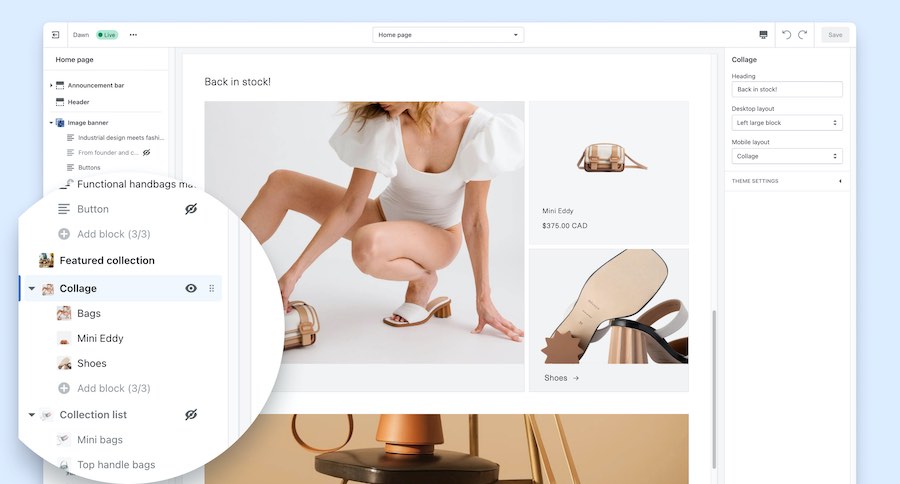
At time of writing, there is just one free OS 2.0 store available — "Dawn," — but the new format unlocks a lot of extremely useful content presentation options, so if you're planning on using a free template, this one is definitely worth considering seriously. (Of the paid-for templates, at time of writing 49 of these use OS 2.0.)
Now, Shopify's new drag and drop editor works a bit differently to Wix's.
Wix's lets you drop anything anywhere on the page, but Shopify's locks things down a bit more tightly — you are dealing more with pre-defined blocks and sections that you move up and down a page. This may be a bit more restrictive, but it does mean that your store design remain fully responsive and 100% smartphone friendly.
Another key difference between working in Wix and Shopify — and as discussed above — is that in Wix you are working with two versions of your site, a desktop one and a mobile one.
This gives you much greater control over the appearance of both, but can also mean more editing.
Ultimately neither platform presents a particularly steep learning curve when it comes to editing a website — some users will prefer the 'immediacy' and flexibility of the Wix front-end editor to Shopify's preview-and-publish approach, but others will appreciate the simplicity of Shopify.
Now, let's take a look at getting content in and out of both platforms.
Importing and exporting content
Both Shopify and Wix make it pretty easy to import products — you can do this via CSV file (with both platforms providing you with a CSV template that you can populate).
Shopify however has an edge when it comes to exports — it's easy enough to export all of your product data from the platform. With Wix, a limit of 5,000 products applies to exports, and you can't export digital goods.
Similarly, Shopify is better for importing and exporting other types of content (pages and posts) — but you will have to use a third-party app like Blogfeeder to do so.
Workarounds do exist for getting blog content out of Wix (usually involving RSS feeds) but these can be a bit technical in nature.
CMS features in Shopify and Wix
The key thing to note about the Shopify and Wix content management systems is that the former's is very much focused on ecommerce, whereas the latter's is more about website building in general.
This is reflected in both platforms' content management systems (CMS) — and you'll find that you get a much wider range of website building components to choose from out of the box with Wix.
These include galleries, social icons, forms, media players, content strips and many others — you can pick one of these and then drag and drop it anywhere you like in your content.
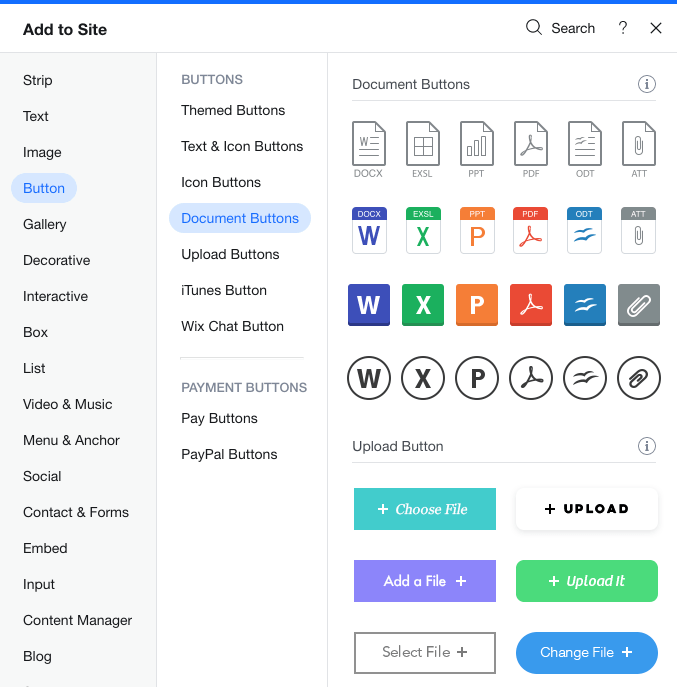
In Shopify, you won't find as large a range of 'content components' to add to pages — especially if you're using one of the 'old' Shopify templates, which basically only let you add text, images or HTML to static pages.
And you won't be able to move what is available around the place quite so easily, even if you're using a new Online Store 2.0 theme.
(On the plus side, and as discussed earlier, this helps ensure that your website remains fully responsive.)
This more restrictive approach might explain why Shopify's CMS is a lot faster, however — I've found the Wix interface to be very sluggish at time, and had to stare at animations for ages whilst waiting for particular features to load.
By contrast, everything happens fairly instantaneously in the Shopify CMS.
One area where the Wix CMS definitely has an edge however is forms. It lets you build bespoke data capture forms and add them to your content really easily.
With Shopify, by default you are restricted to dropping one of two form types into a page — a contact form or an e-newsletter sign-up form, and you can't add custom fields to these. if you want to do this, you'll need to do a bit of coding or install a suitable app.
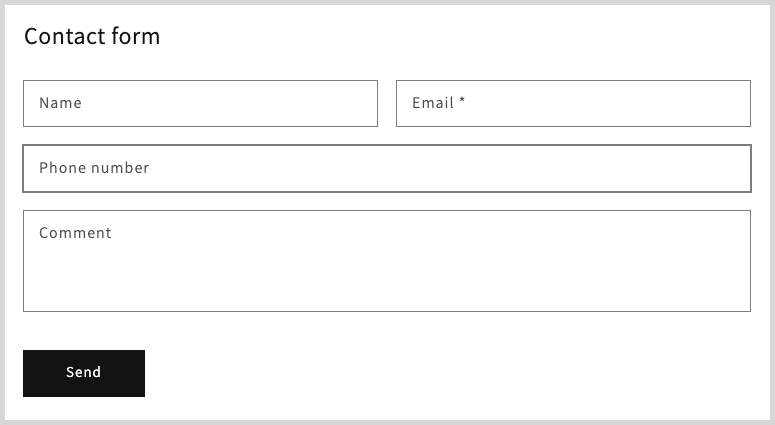
To sum up: Wix's CMS, in many ways, more flexible — but it's also more fiddly and slow, and the sheer number of website building components available can be a bit overwhelming. Overall, I prefer the cleaner, 'walled-garden' approach of Shopify's CMS — but I think improvements could be made to its approach to form building.
Blogging
Both Shopify and Wix allow you to create a blog for your site. This is an essential feature for anybody who is serious about growing their business, because high-quality blogging is one of the best ways you can increase site visibility in search results and attract inbound traffic to your website.
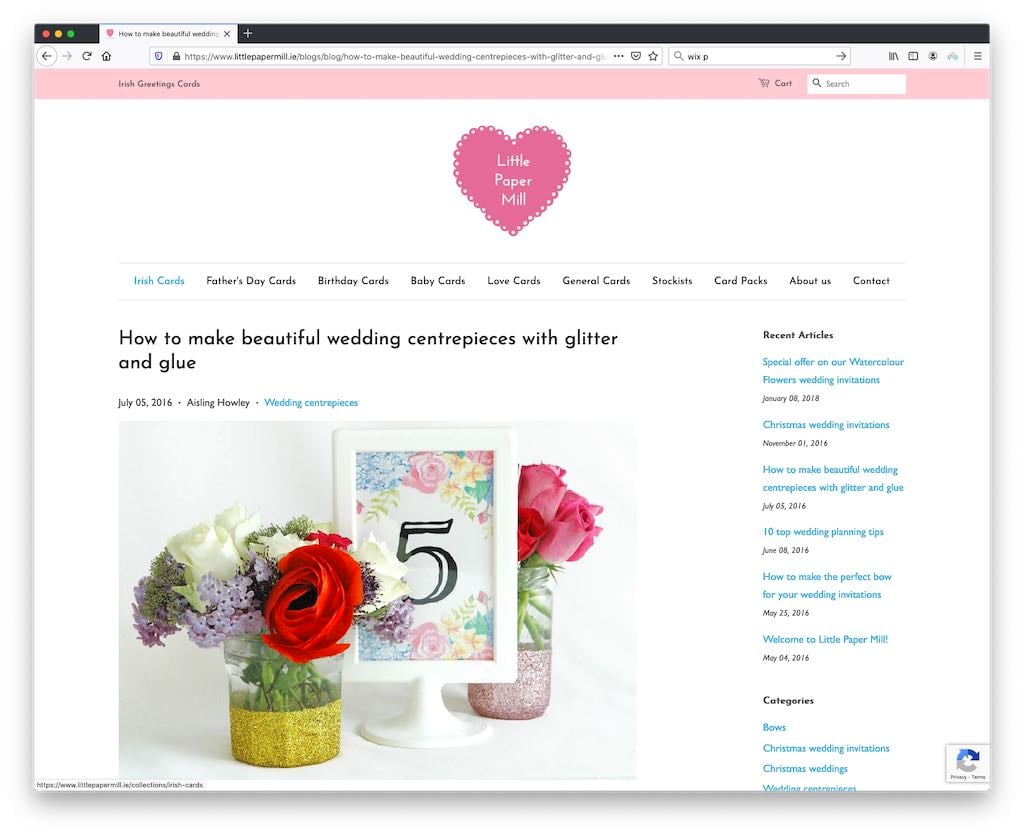
The blogging functionality in both Shopify and Wix is similar — you can create simple posts and categorize them as you please.
Additionally, RSS feeds are available for both Shopify and Wix blogs — these allow other people to subscribe to them easily or feature your blog content on their sites.
Wix has a slight edge in the blogging department however, because it has an autosave feature that prevents you losing content should your computer crash or your internet connection drop.
Additionally, Wix lets you use both categories and tags in your blog posts; Shopify only lets you use tags.
So, a slight win in the blogging department for Wix.
Mobile apps
Wix and Shopify both allow you to manage your store on the go, via mobile apps.
Wix's mobile app is called 'Wix Owner.'
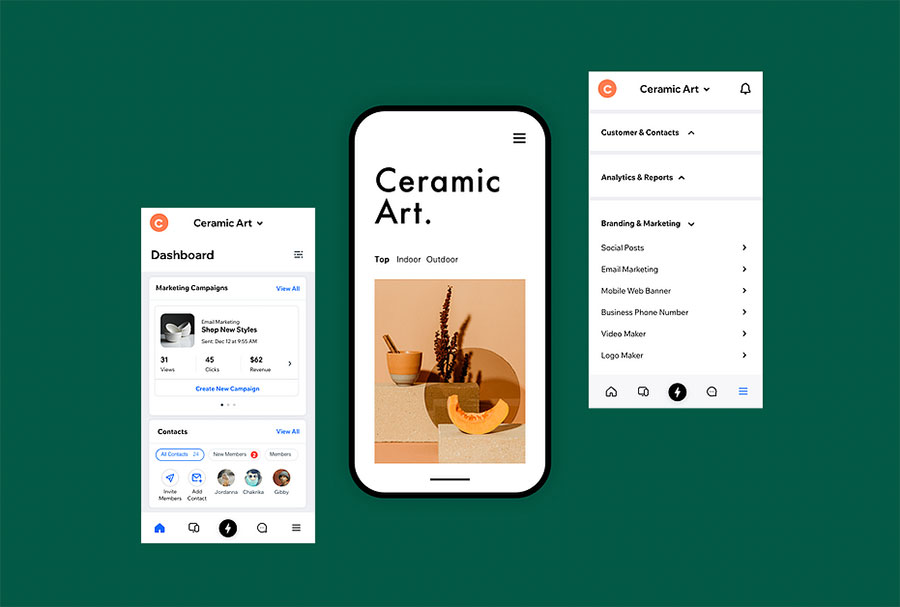
There are actually quite a few mobile apps available for Shopify, but the main ones are:
-
Shopify
-
Shopify
Point of Sale (POS)
The Shopify app is a general-purpose app which lets you manage your store on the go; and, as the name suggests, the Shopify POS app is for Shopify users who are working in a 'point-of-sale' context (i.e., a physical location — market stall, shop etc.) and need to take payment or sync inventory using their mobile device.
In terms of user ratings, Wix's mobile app is rated slightly higher than Shopify's — getting 4.8 and 4.5 out of 5 scores on the iOS and Google Play stores respectively; the equivalent scores for Shopify's main app are 4.6 and 4.3 respectively.
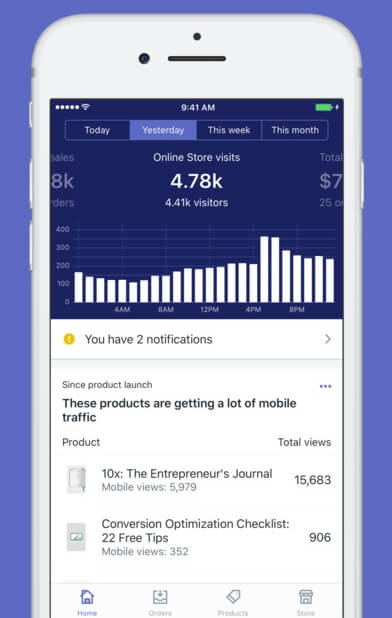
Depending on whether you're an Android or iOS user, you can make use of other Shopify apps. These include a customer chat app ('Shopify Inbox'), an order delivery tracker, a stock photography app and a logo maker.
But it's the main Shopify app that is probably of most relevance to Shopify users.
In terms of which of the mobile apps are better, I'd personally argue — and this probably won't come as a surprise by now — that the Wix app is better suited to those needing to make general edits to their website, and the Shopify ones are better suited to ecommerce.
And speaking of ecommerce…
Ecommerce in Wix vs Shopify
If you're comparing Wix vs Shopify, you are probably especially curious about which of these products is the better option for selling online.
Let's compare their ecommerce features and find out, starting with payment processing.
Payment gateways
A payment gateway is the software you use to accept payments on your site. Both Shopify and Wix provide their own built-in payment gateway: Shopify Payments and Wix Payments respectively.
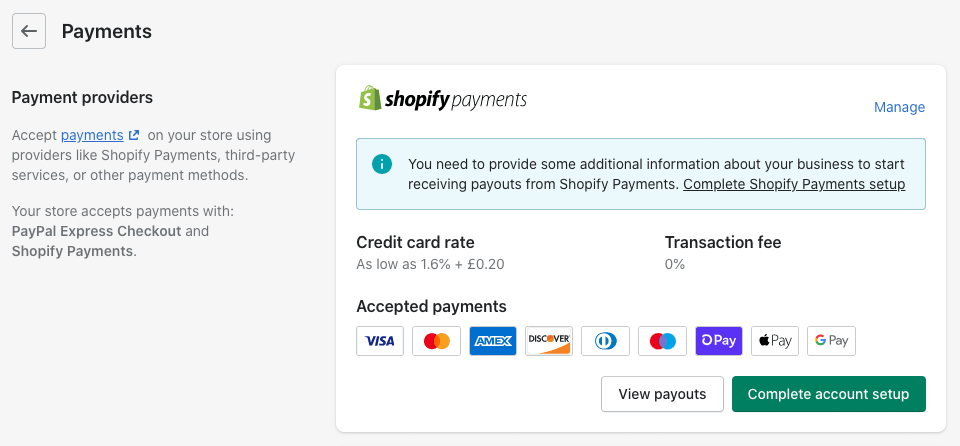
These are not supported in all countries however, so depending on where you're located, you may need to resort to a third-party payment gateway.
Shopify has an edge here, simply because it integrates with a larger range of payment gateways: over 100 to Wix's 70 or so.
However, and as mentioned earlier, Wix gets a thumbs up for not charging you any fees at all for using a third-party payment gateway — Shopify, by contrast, applies transaction fees (which vary according to location and plan type) if you use one.
The bottom line: Shopify's payment options are more extensive — but can be more expensive too.
Now, let's take a look at selling in multiple currencies.
Download our free ecommerce e-kit
For a limited time, we're offering our readers some excellent free tools. Sign up free to immediately receive:
- our online store comparison chart
- a downloadable cheatsheet on how to create an online store
- our SEO, blogging and 'how to start a business' cheatsheets
- extended free trials and discount codes for essential business apps
- our latest tips on ecommerce and growing a business
View privacy notice.
Selling in multiple currencies in Wix and Shopify
You tend to make more online sales if you sell in the currency used by your store visitors.
So, if you're selling in lots of different countries, it's good to be able to let your potential customers choose their own currency — or, better yet, to present your products in your site visitors' currency automatically.
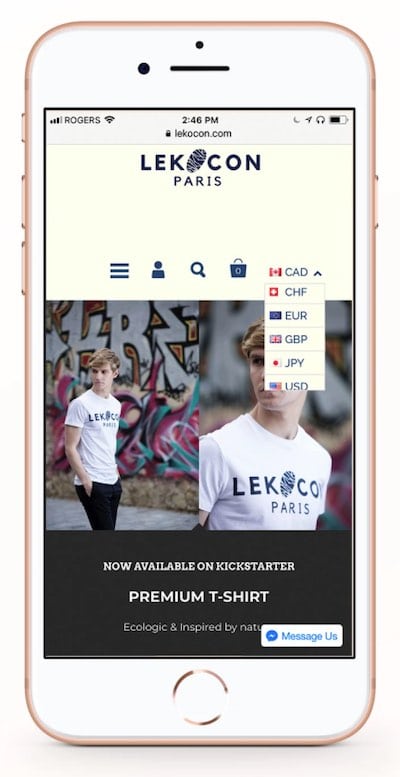
Shopify facilitates full multi-currency payments. There are two ways you can take them:
- use Shopify Payments and a free 'Geolocation' tool
- install a dedicated third-party app like Multi-Currency by Bold Commerce.
Both options let you present prices in a store visitor's local currency and allow them to check out in that currency.
Although Wix does allow you to display prices in different currencies — via a currency converter drop-down menu — store visitors can't yet check out in their own currency.

This matters because the checkout page is a crucial part of the sales process, and you don't want anything present on it — such as a price in a foreign currency! — that could act as a barrier to sale.
For me, the lack of full multi-currency functionality in Wix represents one of the strongest arguments for using Shopify instead.
What about using multiple languages in Wix vs Shopify?
Both Wix and Shopify allow you to create versions of your websites in multiple languages.
Shopify lets you create up to 20 different language sites on all 'Basic' or higher plans.
On Wix, as long as you are building in the 'Wix Editor' version of the platform (i.e., rather than 'Wix ADI' or 'Editor X'), you can enable 'Wix Multilingual' on any plan. There don't appear to be any hard limits on the number of different language versions of your site you can create.
Point-of-sale functionality in Wix vs Shopify
Point-of-sale (POS) functionality allows you to sell in the 'real world' — i.e., in a shop, at a stall, at a concert and so on.
You can use POS to accept payments (usually via card readers that connect to a mobile device) and to handle inventory management (i.e., when you use POS to sell a product in a physical location, your online store's stock levels get updated automatically).
For many years, Shopify has made POS a key feature of the platform, providing things like dedicated POS support, a hardware store and detailed reporting. The point-of-sale features in Shopify are comprehensive, 'baked in' to the platform and very strong.
By contrast, until recently, if you wanted to use POS with Wix, you needed to make use of third-party services Square or SumUp — these have more limited POS features than Shopify and are not available in all countries.
However, Wix has now launched its own POS system — the suitably named 'Wix Point of Sale' — which, like Shopify's works 'out of the box', and contains a more similar feature set.
Unlike Shopify's, however, this is only currently available in the USA, and only to 'select users.' If you live outside the US, you can still use the Square or SumUp options (depending on your location).
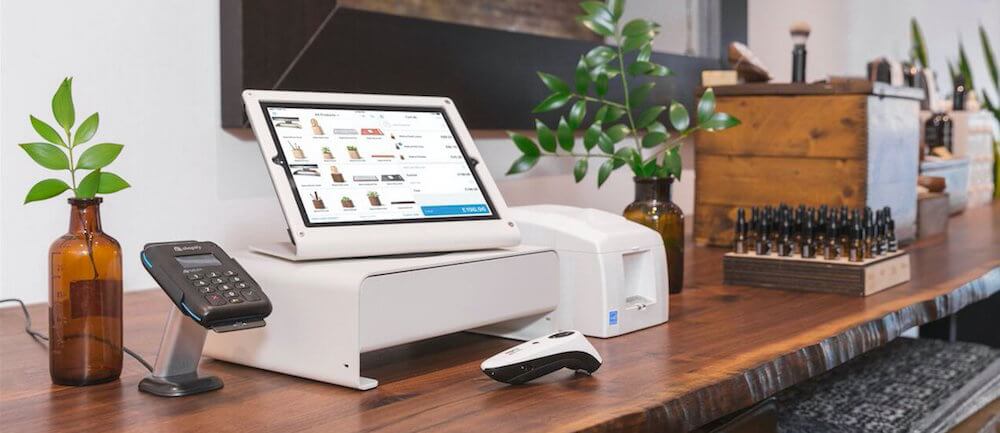
It's important to note however that with Shopify, you may need its 'POS Pro' add-on get the most out of point of sale. The fee for this is not inconsiderable: $89 per month, per location.
Although Shopify's built-in point-of-sale features ('Shopify POS Lite') cover the basics of selling in a physical location, and will be fine for merchants with simple needs, you will need the add-on if you want to:
-
use an unlimited number of registers
-
facilitate 'buy online, collect in store'
-
facilitate exchanges
-
provide custom printed receipts
-
define staff roles and permissions
-
attribute sales to particular staff members.
With Wix's POS system, you don't have to worry about additional fees to get access to most of this functionality. You will still have to pay for hardware (and note that only Wix-approved hardware is supported), but there are no additional software costs.
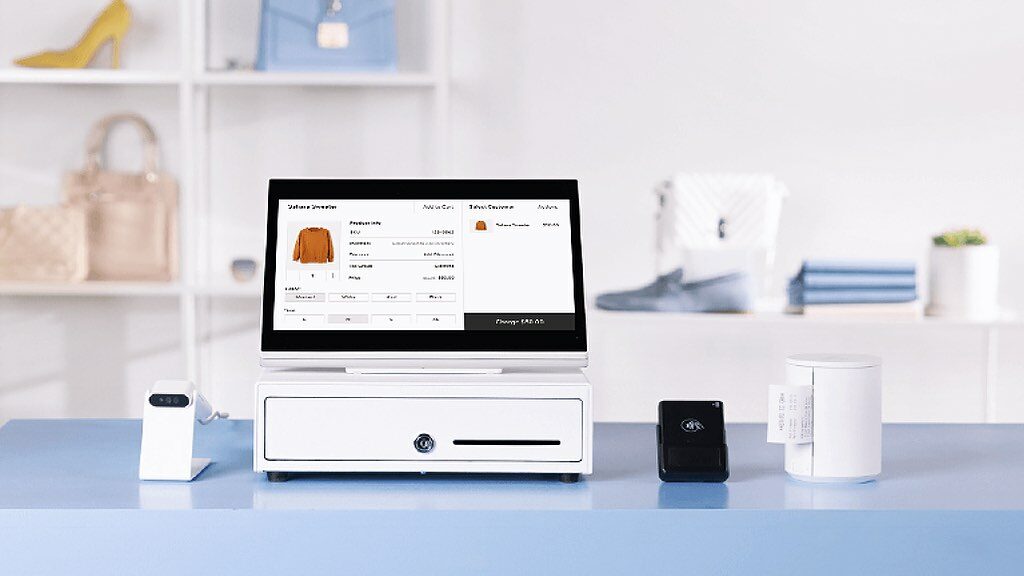
There's no doubt that Shopify's POS functionality is more established and more widely available — but depending on your requirements and location, you may be able to access POS features more cheaply with Wix.
Now, let's take a look at another very important ecommerce feature: abandoned cart saving.
A way to save on Shopify
If you're interested in using Shopify, the company is currently running a time limited offer that essentially gives you a free month's service. Here's how to avail of it:
- Start a trial using this link.
- When your trial is over, you just pay $1 for your first month. This can amount to quite a saving, especially if you are interested in using one of the higher-tier plans.
Abandoned cart recovery features
Abandoned cart recovery is a key piece of ecommerce functionality — it allows you to identify store visitors who added an item to their cart, but didn't complete a purchase.
You can then send a follow-up email to those visitors (usually containing an incentive, like a discount code, to encourage them to complete the transaction).
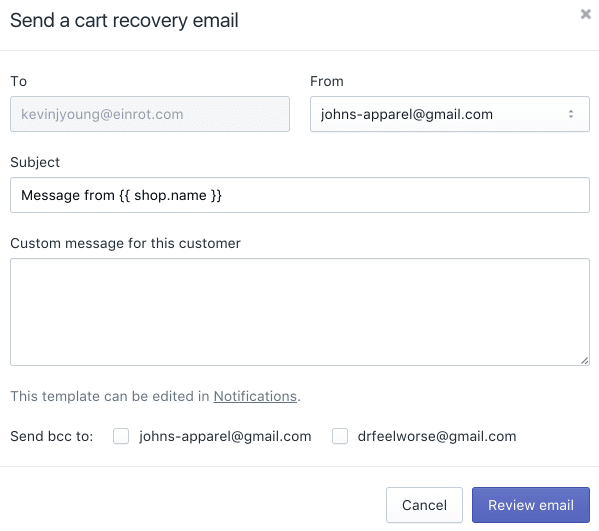
The good news is that Wix and Shopify both feature this functionality, and it's available on all Shopify plans and all Wix ecommerce ones.
You could argue that Wix's abandoned cart functionality is a bit better than Shopify's, because it permits the sending of two automated follow-up emails, whereas Shopify only allows you to send one automated follow-up (there are apps that increase this limit, however).
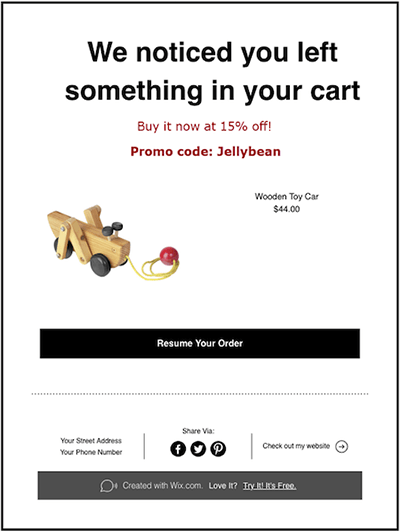
Product options and variants
If you intend to sell products that come in a lot of different shapes and sizes, then something you might want to pay particular attention to in a Wix vs Shopify debate is the limits placed on product options and variants.
Product options are things like size, color and material ('large' or 'green' or 'cotton'); variants are the combinations of these (a large blue suede shoe would be one variant, a small red leather shoe would be another etc.).
Wix has an edge over Shopify here, allowing you to make use of up to 6 product options and 1000 variants.

Shopify's equivalent limits are 3 and 100 respectively, although you can install (paid-for) apps to your Shopify store that remove these limits.
So overall, when it comes to product options and variants, the more flexible choice is Wix.
Product customization / personalization
If you want to give your customers the option to customize their product — for example, by adding text for an engraving — Wix has an edge, because it's easy to add a custom field to a product. With Shopify you will need to add an app or add a couple of lines of code to do this.
Shipping options
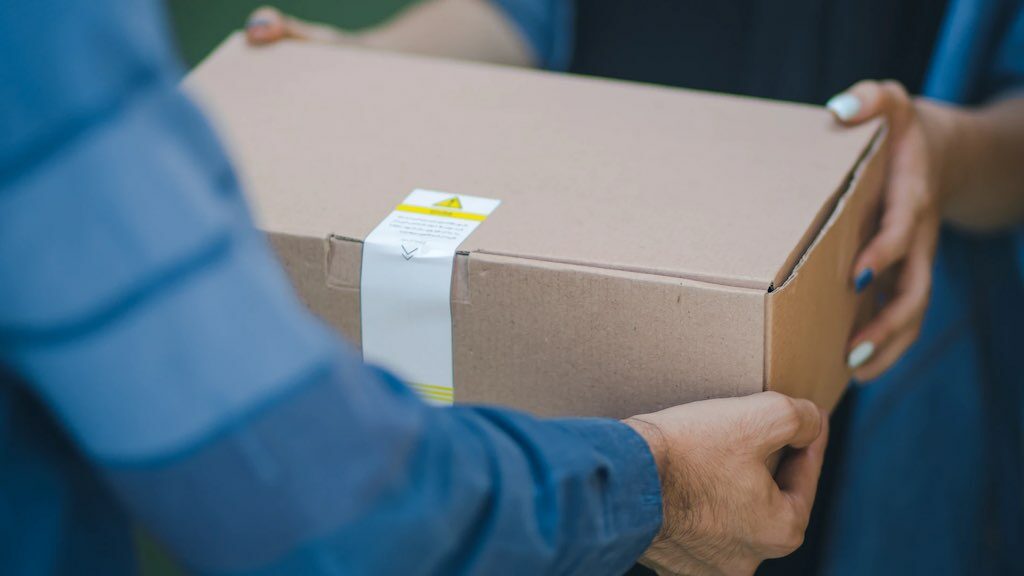
Both Shopify and Wix allow you to create a variety of shipping rules. Both platforms let you offer your customers:
-
free shipping
-
flat rate shipping
-
shipping by weight
-
shipping by price
-
shipping by product.
You can also provide real time shipping quotes to your customers, where your online store connects to a postal service and displays a 'live' shipping price for your item.
Wix provides real-time carrier shipping quotes via USPS in the USA, and via Correios in Brazil. Real-time shipping quotes from other suppliers will involve additional costs — and you'll need to connect the paid-for service ShipStation (or a similar app) to facilitate this.
Shopify's built-in real-time shipping quote functionality caters for more countries — US, Canada and Australia — and postal services. For example, in the USA you can avail of real-time shipping quotes from DHL Express, UPS or USPS, and discounts of up to 88%.
If you've negotiated your own shipping rates with carriers, and wish to display those instead, Shopify lets you do this — additional charges apply however (you can avail of this functionality by upgrading to a 'Shopify Advanced' or 'Shopify Plus' plan; paying an additional monthly fee; or paying for your Shopify plan on an annual basis).
And, as with Wix, you can use ShipStation with Shopify to offer real-time quotes for other suppliers.
The bottom line on shipping: because it is more flexible in terms of the suppliers it allows you to work with for real-time shipping quotes, and offers generous discounts for this service in certain countries, it's a win for Shopify.

Dropshipping
Dropshipping is an online retailing approach where you don't keep what you're selling in stock. Instead, you take an order via your store, send it to a supplier, and they deliver the goods to your client on your behalf. It's an attractive, if competitive, method of selling goods online.
Shopify allows you to connect your store to a very large number of dropshipping companies, via its app store (which I discuss later). However, it's hard to establish which of these dropshipping companies make their goods ethically — the goods on offer in Shopify's dropshipping apps are often made in the Far East, where working conditions can be very poor.

Up until recently, you couldn't dropship with Wix. However, the company recently introduced some integrations with platforms that facilitate it. These include Modalyst, Spocket, Syncee, Printful and Printify.
In fact, two of the Wix ecommerce and business plans now come with dropshipping built in (via Modalyst). However, you will need to be on the $49+ 'Business VIP' plan or higher to use this functionality to the full, as the $23 'Business Basic' plan doesn't facilitate it, and the 'Business Unlimited' plan restricts the number of products you can dropship (to 250).
Ultimately, Shopify offers considerably more choice in the dropshipping department, and indeed is the best option I've come across for dropshipping in general to date — but It'd be great to see a list of ethical dropshipping companies and/or apps made available on the platform.
The Shopify dropshipping starter kit
If you're interested in dropshipping, I'd recommend that you take a look at Shopify's dropshipping starter kit — with this, you get 14 days of free access to Shopify plus lots of bundled resources and tools that show you how to launch a successful dropshipping Shopify store.
You can access the starter kit here.
Selling digital goods and VAT MOSS
Wix and Shopify allow you to sell both physical and digital products. Doing so in Wix is slightly more straightforward, because you get this functionality out of the box — Shopify requires you to add its 'Digital Downloads' app first (there is no charge for this, however).
Despite the fact that you can get started with digital downloads a bit easier with Wix, I'd argue that Shopify is — for EU users at least — the better bet for selling digital goods, because it handles an EU tax called 'VAT MOSS' more effectively.
VAT MOSS is basically a requirement that sellers of digital products to consumers in the EU add value added tax (VAT) to each digital product on a per-country basis (i.e., there's one VAT rate to be applied for France, one for Ireland and so on).
Unlike Wix, Shopify calculates the appropriate rate automatically — there's no messing about with setting up manual tax rules and so on. This is an extremely useful piece of functionality, which for me makes Shopify a more obvious choice than Wix for merchants selling digital goods.
And on top of the neat handling of VAT MOSS, Shopify is more generous when it comes to file size limits — your digital goods can be 5GB in size, to Wix's 1GB.
So all in all, if you're setting up a store specifically to sell digital goods, Shopify is a very good choice and a better option than Wix (or indeed competing platforms in general — of the platforms I've reviewed, I've yet to come across an online store builder that handles VAT MOSS better).
A featured alternative to Wix and Shopify: Squarespace
It's worth focusing a moment on a key rival to both Wix and Shopify — Squarespace.
Like Wix, it is a hosted solution, so it's easy to set up and comes with a lot of built-in features, like email marketing and ecommerce (and includes comprehensive support).
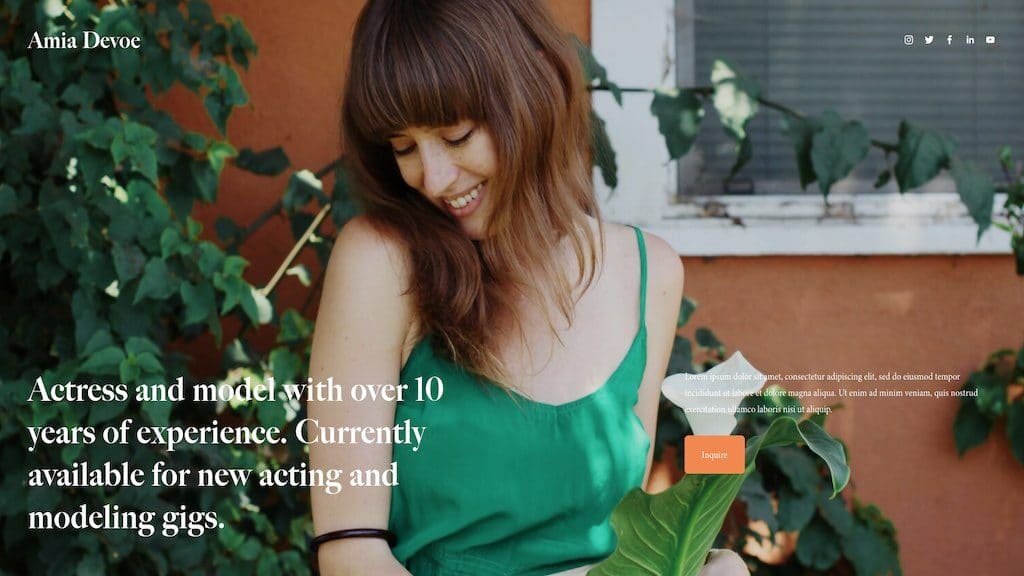
Unlike Wix, however, Squarespace allows you to create fully responsive sites; and unlike Shopify, it's really good for creating sites that aren't exclusively focussed on ecommerce.
Find out more about Squarespace here.
And on a related note, let's take a look at how Wix and Shopify handle tax in general…
Tax calculations in Wix and Shopify
Wix and Shopify both let you calculate and apply tax rates to your products automatically, but they do so in quite different ways.
If you're a Wix user, you use the third-party Avalara app to apply the correct rate — and you have to be on a 'Business Unlimited' or 'Business VIP' plan to do so.
On the plus side, the Avalara app gives you the ability to apply the correct taxes for just about any country — but on the down side, you are limited to a certain number of calculations per plan (100 per month on the 'Unlimited' plan; 500 on the 'Business VIP' plan', and negotiable on the 'Enterprise' plan). These limits won't be adequate for any users with a large number of sales per month.
With Shopify, automatic tax calculation is a built-in feature and no limits are applied to the number of calculations you can make each month. However, the feature only fully works for US, EU, UK and Canadian users — merchants based in other countries may have to resort to a paid-for app from the Shopify app store to meet their needs.
So, of the two products, Shopify is unquestionably the better option for tax calculations if you operate from the US, EU, UK or Canada; if not, you'll need to research the best Shopify app for your needs and see how it stacks up against the Wix Avalara integration.
And speaking of integrations…
Integrations and apps
Both Wix and Shopify provide app stores featuring a range of add-ons for your site — these let you add or improve both platforms' functionality considerably.
In both stores you'll find apps that handle key tasks like product reviews and ratings apps, digital downloads, gift cards, dropshipping, tax calculations and accounting tasks.
The Wix and Shopify app stores are a bit different in nature however, as the Wix app store is stocked with apps that generally let you add additional features to your site, whereas the Shopify app store is as much about integrations (for example with email marketing apps, accounting apps and CRM apps) as it is about add-ons.

If you're looking for integrations with other tools in Wix, you'll find these in the dashboard of your site, in the 'Marketing Integrations' section.
The quantity of apps and integrations available for Shopify dwarves that of Wix (there are 6,000+ Shopify apps to Wix's 250+), but there is an important omission in Shopify: an official Mailchimp integration (due to a dispute over data protection, Mailchimp removed their app from the Shopify app store).
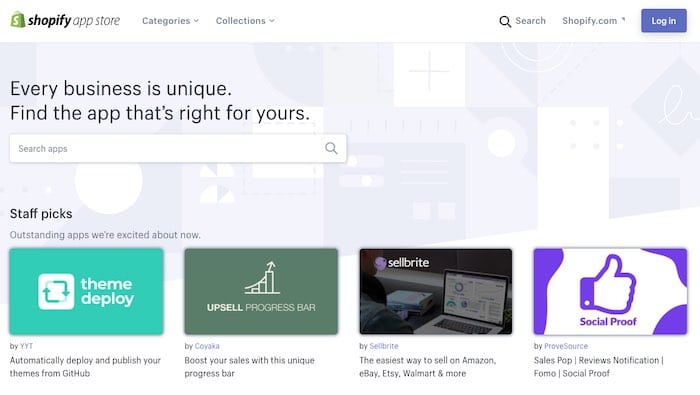
There are several other email marketing apps available however, which cater for other popular solutions like GetResponse, Aweber and Campaign Monitor.
Mailchimp app aside, the overall winner in the integrations and apps department is Shopify.
Email marketing tools
Wix and Shopify both come with bundled email marketing tools — and pretty generous email marketing tools at that.
In Wix, you can send 3 e-newsletters to an audience of 5,000 subscribers a month for free; if that's not enough for you, you can upgrade to a paid-for plan and extend this limit.
Shopify's recently introduced email marketing tool, 'Shopify Email,' lets you send 2,500 emails per month for free, with a $1 fee applying to every additional 1,000 messages you send.
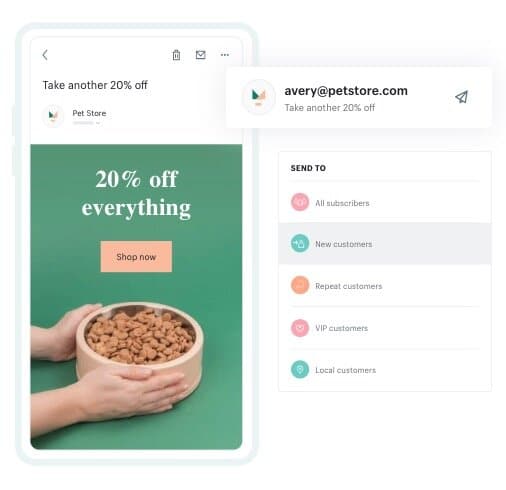
Now, the email marketing functionality available in both platforms is not going to rival that which you'll find in dedicated email marketing tools — for example, you won't find the sort of advanced autoresponder features you'd get in platforms like GetResponse or Mailchimp.
But that said, Wix does offer some pretty decent automation features on its paid-for email marketing plans — the functionality provided on them is currently stronger than the Shopify equivalent.
Ultimately, if your needs are basic, you may find both Wix and Shopify's email marketing tools very useful indeed — not to mention reasonably priced. But of the two, the stronger features are provided by Wix's offering.
SEO tools in Wix vs Shopify
A key question for prospective users of Wix and Shopify is this: how good are the search engine optimization (SEO) features?
Well, both products handle the basics of technical SEO well, allowing you to easily tweak page titles, meta descriptions, headers and robots.txt files.
However, I'd argue that in most respects, Shopify outperforms Wix in the SEO department, especially where mobile search is concerned.
First, and as discussed above, Shopify sites are fully responsive — Wix's are not. Given that Google's algorithm has a preference for responsive sites, and applies a 'mobile first' approach to indexing, this gives Shopify an immediate edge when it comes to SEO.
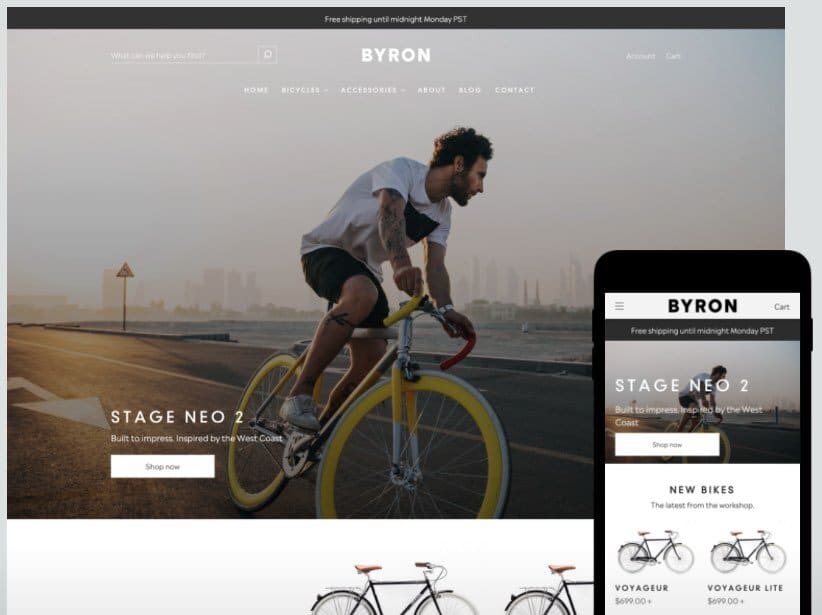
Second, you can use Accelerated Mobile Pages (AMP) on Shopify product pages, but not on Wix ones (Wix limits its use to blog posts). AMP is a Google-backed project which aims to speed up the delivery of content on mobile devices through the use of stripped down code known as AMP HTML.
Using AMP on your product pages can bring about improvements in search results, thanks to faster loading times and longer user 'dwell times' — both are rewarded by search engines.
(With Shopify, you'll need to pay for an app to enable this functionality, but the point is, it's available!)
Third, any time you change a page or product URL in Shopify, it automatically creates a 301 redirect for you (a 301 redirect lets search engines know that a page has moved location, and forgetting to do this can cost you dearly in search).
In Wix, you'll need to have to create this redirect yourself, using a different section of the interface to do so. (On the plus side, you are prompted to do so by Wix as soon as you start changing a page's URL).
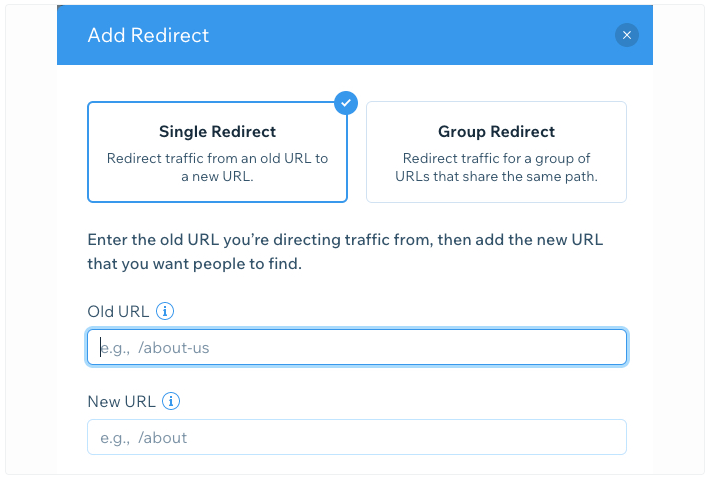
And fourth, it's arguably easier to get a Shopify store to meet Google's new 'Core Web Vitals' requirements. Core Web Vitals are a set of targets relating to the speed, responsiveness and visual stability of a website; and sites that meet them can receive preferential treatment in Google search results. The Shopify app store provides a range of apps that help you do this; and the fact that its template designs are responsive gives the platform a built-in advantage on this front too.
There is an aspect of Wix's SEO functionality which is definitely better than Shopify's: you can create 'cleaner' URLs. In Shopify, a prefix is applied to products and pages (i.e., /products/ and /pages/) which, whilst not being a disaster from an SEO point-of-view, is not ideal; Google prefers simpler URLs.
Wix also provides a feature which SEO newbies might find useful — 'SEO Wiz.' As the name suggests, this is a wizard-style tool which asks you various questions about your site and comes up with a checklist containing SEO recommendations for you to follow.
This tool should not be considered as a substitute for working with a professional SEO expert, but it's a good starting point and a way to get acquainted with the principles of SEO.
Finally, it's worth remembering that regardless of which of these two platforms performs best from a technical SEO perspective, your site will only ever rank in search results if good keyword research has been applied, its content is strong and it has a lot of links pointing to it.
Ultimately I'd say that either a Shopify or a Wix site can rank well in search results if the content and link building strategies are strong enough.
But due to the fact that it meets Google's technical SEO expectations much more effectively (both in terms of Core Web Vitals and responsive templates), the best performing option for those working in competitive niches will, in most cases, be Shopify.
I am not a lawyer, so please note that the below observations should not be interpreted as legal advice, but rather as my best understanding of how Wix and Shopify perform from a GDPR point of view. It's usually best to consult a lawyer to get a full understanding of your obligations under GDPR.
In the light of the introduction of the General Data Protection Regulation rules (GDPR) introduced by the EU in May 2018, business and website owners now have a lot of additional legal responsibilities; and there can be fairly serious penalties for not taking them seriously.
For me the key GDPR tasks for website owners are usually as follows:
-
Display adequate privacy and cookie notices on your website
-
Process and store user data securely
-
Get explicit consent from people signing up to mailing lists that it is okay to send them e-newsletters
-
Provide a way for users to consent to use of non-essential cookies on your site before they are run.
Generally speaking, hosted website builders like Wix and Shopify let you manage the first three requirements pretty well — but not the fourth one.
However, unlike many of its competitors, Wix actually handles cookie consent reasonably well — a built-in cookie consent banner lets you block cookies for quite a few popular marketing products before they are run (Facebook pixel, Google Analytics etc.).
It's not perfect, because it only supports cookies for a small list of services, but it will cater for a lot of users.
Wix users requiring a more advanced cookie management solution can use paid-for tools like CookieYes — a bit of configuration is required though to get these sort of tools working, however.
Doing so will provide you with a proper GDPR cookie management solution that's easy to set up and manage — but additional fees will apply.
Bottom line on GDPR: you can make a Shopify or Wix site GDPR-compliant, but it will involve some work (and ongoing fees, if you're using a third party cookie banner solution).
In my view, because there are quite a lot of apps available for Shopify that handle GDPR adequately, it is the slightly better choice here. But it would be preferable if, as is the case in Wix, GDPR cookie consent was a core feature in Shopify.
Security
A key advantage of using a hosted solution like Wix or Shopify — as opposed to using a self-hosted platform like WordPress — boils down to security. Both companies are technically responsible for it; you don't have to worry about keeping themes or plugins up to date.
Both platforms give you:
- SSL certificates
- PCI compliance
- 2-factor authentication
Wix has one edge in this area however, as it also backs up your site periodically. With Shopify, you'll need to use a third-party app to do so, or export your product data from time to time.
Customer support
Another big advantage of using a hosted solution like Wix or Shopify over a self-built, hosted one is that you get customer support included.
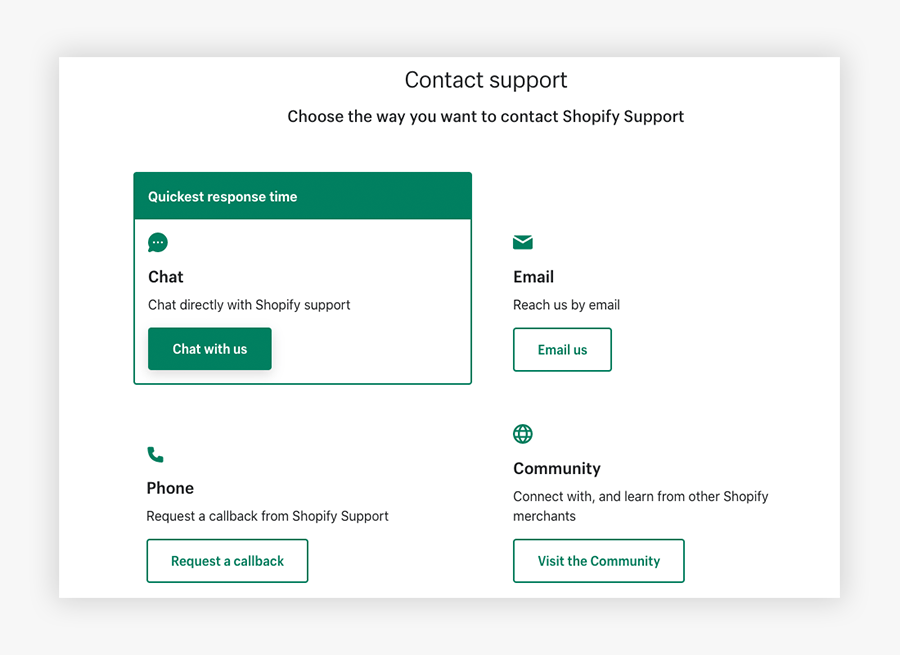
With Wix, you can avail of customer support via email or phone. Shopify provides email, phone or live chat support. There are also extensive 'knowledge-base' resources for both platforms that you can browse, and community forums that you can pose questions to.
Both Shopify and Wix make it harder than you might like to actually find any contact details — you often have to search for an answer to your query before you are given access to any email forms or phone numbers.
I understand the rationale behind this approach (encouraging the user to solve their own problem without recourse to an agent is a cost-saver!), but I'm not particularly a fan of it.
A couple of other things worth bearing in mind regarding customer support for both platforms are as follows:
-
If you go for a paid-for template on Shopify (i.e., as opposed to using one of the bundled themes) you may need to contact a third-party developer for support with technical issues relating to this template. How good this support is will depend on the provider of the template.
-
Both platforms now use a 'request callback' approach to phone support.
- Shopify support is available in more languages — 21 to Wix's 9.
- 24/7 customer support is available for both platforms in English, but if you need support in a different language, you may encounter more restrictive support hours.
Wix vs Shopify conclusion
Overall, Wix is the more obvious choice of the two platforms for anyone wishing to build a 'general-purpose' website. Its page layout tools, email marketing, data capture and wider range of templates make it more suitable for those kinds of users. For ecommerce applications, however, the better choice is definitely Shopify.
This is because Shopify's fully responsive templates, support for AMP on product pages, dropshipping features, true multi-currency selling functionality and its wide range of integrations with other key apps make it the more appropriate, professional choice for anyone wishing to build an online store.
To sum up, here is a run-down of why you might use one of these products over the other:
Advantages of using Wix over Shopify
-
Wix provides an entirely free plan without a time limit (albeit one featuring prominent advertising for Wix).
-
Wix is a better tool for creating a 'general-purpose' website. It's easier to add features like galleries, forms and events to a Wix site than it is with Shopify.
-
Wix is slightly more affordable than Shopify
, especially where ecommerce is concerned. -
There are no transaction fees to worry about in Wix if you use a third-party payment gateway.
-
A much wider range of bundled templates is available in Wix than in Shopify.
-
You can feature blog content on static web pages more easily in Wix.
-
You can send more automated abandoned cart reminders with Wix.
-
It has built-in tools for managing cookie consent (for certain scripts) in a GDPR-compliant way.
-
Wix's product options / variants limits are considerably more generous than Shopify's
- Its built-in email marketing features are stronger.
-
An official integration with Mailchimp is available for Wix; this is not the case with Shopify.
-
It's easier to create bespoke forms and capture data in Wix than in Shopify.
-
You can create 'cleaner' URLs in Wix; this is good from an SEO point of view.
You can try Wix for free here.
Advantages of using Shopify over Wix
-
Shopify's templates are fully responsive; Wix's aren't.
-
You can allow users to check out in multiple currencies with Shopify — you can't with Wix.
-
Shopify's dropshipping features are more extensive.
-
Shopify is better for point-of-sale applications.
- SEO functionality is better in Shopify than Wix.
-
If you're based in the US, EU, the UK or Canada, the automatic tax calculation features are much better.
-
Shopify calculates and applies VAT MOSS rates automatically — this is a huge timesaver for anyone selling digital goods in the EU.
-
You can switch templates easily with Shopify — this is not the case with Wix, which forces you to rebuild your site if you want to move to another template.
-
There is a much wider range of apps and integrations available for Shopify.
-
Exporting content is more straightforward in Shopify.
-
Although Shopify's interface is less flexible than the Wix equivalent, it's arguably easier to use.
-
A wider range of payment gateways is available for Shopify.
-
The Shopify 'Buy Button' lets you use the platform to add a shopping cart to an existing website or social media profile (and is available for just $9 per month).
You can access a free trial of Shopify here.
The alternatives to Wix and Shopify
For ecommerce applications, I'd suggest that BigCommerce is well worth investigating as an alternative to Wix and Shopify — it is a professional ecommerce platform with a feature set that is comparable to Shopify's. (In fact, many features that require an app purchase in Shopify are available out of the box in Bigcommerce.) Check out our BigCommerce vs Shopify comparison for more details.
(Shopify is probably still a better bet for those interested in POS or dropshipping, however.)
For general website building purposes, Squarespace is definitely worth a look — it offers a really easy-to-use interface and better blogging tools than either Shopify or Wix, and also comes with a good range of ecommerce features. Integrating it with third-party services is a bit harder however, and the ecommerce functionality isn't as strong as Shopify's. Check out our Squarespace review for a full run-down on this platform.
If you're on a very low budget, and only selling a few products, you could consider Big Cartel or GoDaddy — but you should note that their ecommerce features are quite limited compared to those of Shopify and Wix. For more details, you can read our Big Cartel vs Shopify comparison here, our full Big Cartel review here and our Shopify vs GoDaddy shootout here.
Finally, you could also consider using an online marketplace like Amazon or Etsy to build your online store. Although these kinds of platforms work in a very different way to hosted website builders like Wix and Shopify, thanks to their existing (and very large) userbases, they can provide a very effective way to sell products online.
If you're interested in learning more about using Amazon or Etsy to build an online storefront, you can take a look at our Shopify versus Amazon and our Shopify versus Etsy comparisons.
Shopify vs Wix…over to you!
Now: over to you. Got any questions on Wix vs Shopify? Let us know! Just leave a comment with your query below and we'll do our best to help.
Wix vs Shopify FAQs
Can I use Wix and Shopify for free?
Yes. In the case of Wix, an entirely free plan is available — but you should note that any sites built with it will feature highly prominent Wix advertising. In the case of Shopify, a 14-day free trial is available.
Which is cheaper, Wix or Shopify?
Technically Shopify is the cheapest option for ecommerce. Its 'Lite' plan is available for $9 per month, and the cheapest Wix plan that lets you sell products, 'Business Basic,' costs $23 per month. However, the Wix 'Business Basic' plan lets you build a fully-functional standalone online store, whereas Shopify's 'Lite' plan only lets you embed your products on other sites. The cheapest Shopify plan that lets you build a standalone store is the $29 'Basic' plan.
Which is better for selling in multiple currencies, Wix or Shopify?
Shopify's multi-currency functionality is stronger than Wix's. Although Wix lets you display your store prices in local currencies, it doesn't let your store visitors check out in their own currency. Shopify, by contrast, does — and this can lead to more sales.
Which is better for SEO, Wix or Shopify?
Shopify is stronger from an SEO point of view, because unlike Wix it uses fully responsive design (something that can lead to preferential treatment in search results) and gives you more ways to meet Google's new Core Web Vitals standards.
Can I use Shopify with Wix?
Yes. You can embed products from a Shopify store on a Wix website by using the Shopify 'Buy Button' feature. This involves adding a snippet of Shopify code to your Wix site, which will then display products from your Shopify store.
How we tested these products
We tested these products via independent research and, more importantly, via hands-on experience of them.
We regularly help clients build online stores, and have extensive knowledge of how both Wix and Shopify work. So this comparison is based on building many stores from scratch; editing existing ones; and using a wide variety of apps to configure them.
Did you know? This article is now available in French. Check out our 'Wix ou Shopify' post on the new Style Factory France website!
Squarespace Vs Shopify Vs Wix
Source: https://www.stylefactoryproductions.com/blog/wix-vs-shopify
Posted by: toddafrourned.blogspot.com

0 Response to "Squarespace Vs Shopify Vs Wix"
Post a Comment